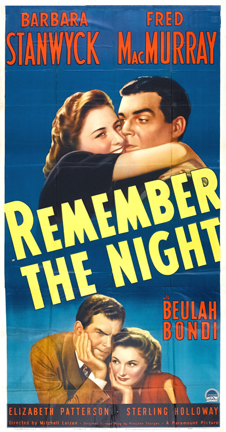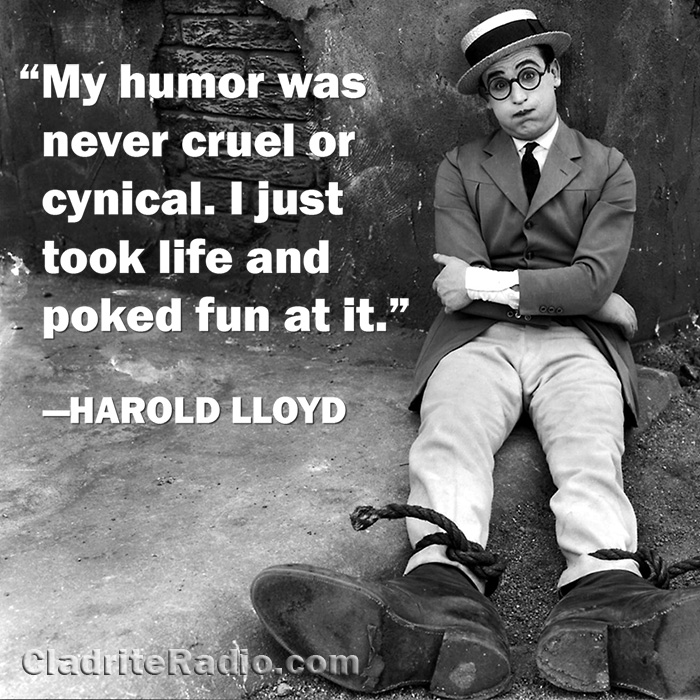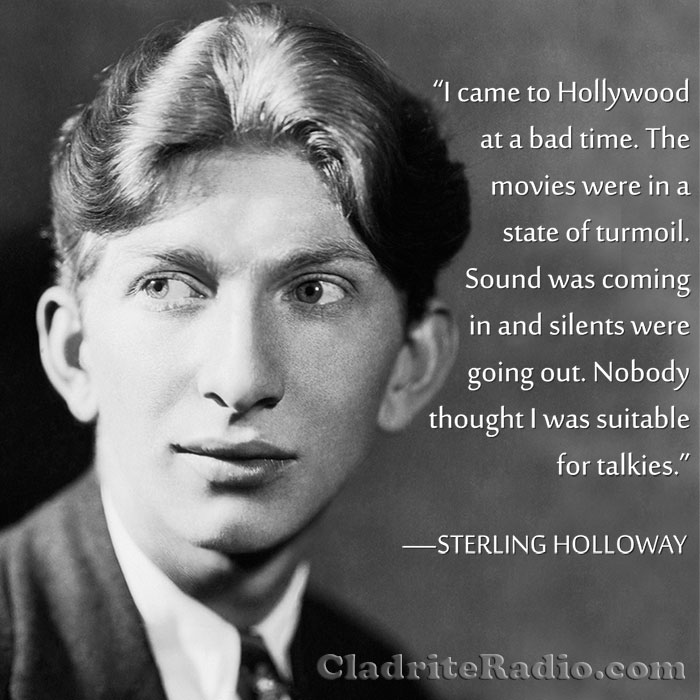Here are 10 things you should know about Sterling Holloway, born 119 years ago. His shaggy-dog appearance and unique voice made him very much in demand as a character actor.
Tag: Sterling Holloway
Remember to Watch ‘Remember the Night’
 If you think you’ve seen every classic Christmas picture (and most of them one too many times, at that), you’ll be pleasantly surprised, we hope, to learn of one that’s flown under the radar of many a classic movie buff.
If you think you’ve seen every classic Christmas picture (and most of them one too many times, at that), you’ll be pleasantly surprised, we hope, to learn of one that’s flown under the radar of many a classic movie buff.
Remember the Night (1940) was the last movie Preston Sturges wrote before moving into the director’s chair with The Great McGinty (1940). Mitchell Leisen directs here, and though Sturges was said to have been disappointed with Leisen’s efforts, it’s hard to imagine why. It’s a terrific picture, one that should be every bit the holiday favorite that pictures such as It’s a Wonderful Life, Miracle on 34th Street, The Shop Around the Corner, and others have become.
Remember the Night features Fred MacMurray as an ambitious assistant D.A. in NYC who finds himself with shoplifter Barbara Stanwyck on his hands because he has asked for a delay in her trial, so as to avoid the jury feeling any holiday-inspired sympathy for her.
It soon comes out that both the D.A. and the dame are Hoosiers, so she accompanies him on a road trip to visit their respective families. Stanwyck’s brief visit with her mother doesn’t go so well, though, so she sticks with MacMurray, whereupon romance and laughs ensue.
Remember the Night is plenty sentimental enough to qualify as a holiday classic, but like It’s a Wonderful Life, it’s got a dark side, too, delivered with gimlet-eyed bite. Apart from a brief appearance by regrettably stereotypical Black valet character, played by Fred Toones, who does his best with what he’s given, it’s well night perfect.
This post was first published in slightly different form on December 6, 2013.
Happy 124th Birthday, Harold Lloyd!
Comedy giant Harold Lloyd was born 124 years ago today in Burchard, Nebraska. Here are 10 HL Did-You-Knows:
- Lloyd’s parents fought frequently when he was a child (due in large part to his father’s penchant for launching unsuccessful, short-lived businesses); they divorced when he was a teenager, after which Lloyd and his dad moved west to San Diego. In 1912, Lloyd, who’d acted on stage since childhood, began to work in one-reel comedies for the Thomas Edison company. His first role was a Yaqui Indian in short called The Old Monk’s Tale.
- Before long, Lloyd moved to Los Angeles, where he became friends with aspiring filmmaker Hal Roach. Roach told Lloyd that when he was able to produce his own pictures, he’d make a star out of Lloyd. When Roach opened his studio in 1913, the pair began to collaborate on creating Lloyd’s first recurring role, Lonesome Luke, a character influenced greatly by Charlie Chaplin‘s Tramp.
- Within a few years, Lloyd began to shift toward the character that is better remembered today, often referred to as the “Glass character” for the round specs that he wore. “When I adopted the glasses,” Lloyd said in a 1962 television interview, “it more or less put me in a different category because I became a human being. He was a kid that you would meet next door, across the street, but at the same time I could still do all the crazy things that we did before, but you believed them. They were natural and the romance could be believable.”
- In his Lonely Luke days, Harold Lloyd gave actress Bebe Daniels his start. The credits usually listed Lloyd’s character as “The Boy” and Daniels’ as “The Girl.” The pair were romantically involved for a time. After five years, Daniels went on to a very successful career as a leading lady. Daniels’ replacement in Lloyd’s pictures was Mildred Davis, whom he wed in 1923. They were married until her death in 1969.
- In 1919, while shooting some publicity photographs, Lloyd suffered extensive damage to his hand while lighting a cigarette with a prop bomb that he thought was just a smoke pot. The bomb exploded, and Lloyd lost his thumb and forefinger. He also suffered burns on his face and incurred damage to one of his eyes (luckily, his sight was unaffected).
- Lloyd and Roach began focusing on feature-length pictures, rather than shorts, in 1921, and when the pair parted ways in 1924, Lloyd launched his own production company.
- Though Buster Keaton and Chaplin are today considered the greatest comedians of the silent era, in the 1920s, Lloyd’s pictures made more money than either (in large part because he was so prolific—he made 12 full-length features in that decades to Chaplin’s four).
- In the late 1920s, Lloyd built a home in Beverly Hills he called Green Acres that boasted 44 rooms, 26 bathrooms, 12 fountains, 12 gardens, and a nine-hole golf course. Though the surrounding grounds have been subdivided, the main house and the estate’s principal gardens are still there, and the estate is listed on the National Register of Historic Places.
- It’s been reported that Lloyd was approached to portray Elwood P. Dowd in the original Broadway production of Mary Chase’s play, Harvey. When Lloyd turned the part down, the role went to Frank Fay.
- Lloyd’s post-cinema hobby was 3-D photography; among his works were portraits of Hollywood stars such as Marilyn Monroe, John Wayne, Sterling Holloway, Richard Burton and Roy Rogers. He also shot a good many nude…er, artistic photographs of more anonymous starlets of the day.
Happy birthday, Harold Lloyd, wherever you may be!

Happy 112th Birthday, Sterling Holloway!
Character actor Sterling Holloway was born 112 years ago today in Cedartown, Georgia. Here are 10 SH Did-You-Knows:
- Holloway was the first of two sons born to grocer (and Cedartown mayor for one year when Sterling Jr. was seven years old) Sterling P. Holloway, Sr. and his wife, Rebecca.
- Holloway graduated from Georgia Military Academy in 1920 and though only 15, he immediately left the South for New York City to attend the American Academy of Dramatic Arts (Spencer Tracy was a classmate and friend).
- In his late teens, Holloway joined a touring company of The Shepherd of the Hills, performing in a series of one-nighters out west. Afterwards, he returned to NYC, where he performed small roles in Theatre Guild productions. He also was cast in the Rodgers and Hart review The Garrick Gaieties, in which he introduced the popular standard Manhattan.
- In 1926, Holloway moved to Hollywood to pursue a career in pictures, and he would go on to appear in 100 of them. His bushy red hair and prominent features made him a natural for comedies, and he got his start in silent pictures, appearing in three shorts and one feature (Casey at the Bat [1927]).
- In 1932, after four years without a film role (a director had reportedly told him he was “too repulsive” for silent pictures), Holloway began to work in talkies, where his high-pitched, chalky voice served him well, and he kept very busy indeed. From 1932-35, he averaged 10 pictures (some of them short subjects) a year.
- Over the course of his 50-year, Holloway appeared in (or did voice work for) more than 100 features and shorts, and made nearly as many television appearances.
- In addition to his picture and television work, Holloway worked frequently on radio, a medium to which his unique and memorable voice was well-suited. Among the shows to which Holloway lent his talents were The Railroad Hour, The United States Steel Hour, Suspense, Lux Radio Theater and Fibber McGee and Molly.
- Holloway was one of the first actors to make the jump to television, appearing in 1949 on the anthology series Your Show Time, which featured half-hour adaptaions of literary short stories from the likes of Sir Arthur Conan Doyle, Henry James and Robert Louis Stevenson. It was the first American dramatic series to be shot on film and the first series to win an Emmy award.
- Holloway frequently did voice work for animated features, including Dumbo (1941), Bambi (1942), Alice in Wonderland (1951), The Jungle Book (1967), The Aristocats (1970) and perhaps most famously, he provided the voice of Winnie the Pooh in Disney’s popular series of Pooh featurettes.
- College Street, where the Holloway family resided in Cedartown, is now called Sterling Holloway Place and there’s a plaque at the site of his boyhood home.
Happy birthday, Sterling Holloway, wherever you may be!

